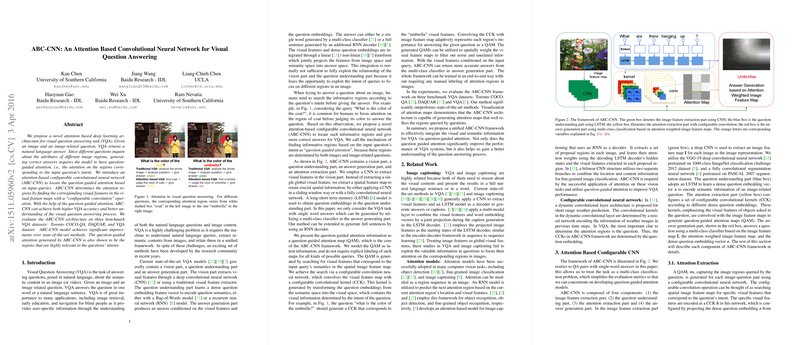An Examination of ABC-CNN: An Attention-Based CNN for Visual Question Answering
The paper "ABC-CNN: An Attention Based Convolutional Neural Network for Visual Question Answering" presents a sophisticated approach to enhancing the capabilities of visual question answering (VQA) systems. The authors propose an innovative architecture named the Attention-Based Configurable Convolutional Neural Network (ABC-CNN), which leverages question-guided attention to improve the accuracy of VQA tasks.
At the core of the ABC-CNN model is the concept of "question-guided attention," a mechanism that allows the model to focus on specific image regions relevant to the questions posed. This is facilitated by a "configurable convolution" operation, where the model dynamically constructs convolutional kernels conditioned on the semantic content of the question, thus highlighting pertinent visual features within images. Such an approach addresses a critical limitation in previous models, which often fail to exploit the full potential of the relationship between image regions and question semantics.
The architecture of ABC-CNN includes four main components: the image feature extraction part, the question understanding part, the attention extraction part, and the answer generation part. The image feature extraction uses either the VGG-19 network or a fully convolutional network to acquire detailed spatial feature maps. Question understanding is handled using an LSTM to generate dense question embeddings, which inform the generation of the attention maps through configurable convolutional kernels. These attention maps, represented as question-guided attention maps (QAMs), directly influence the answer generation process by emphasizing essential image features.
Significant experimental results are reported across several benchmark datasets, including Toronto COCO-QA, DAQUAR, and VQA. The performance enhancements over state-of-the-art methods, such as improvements in answer accuracy and WUPS scores, underline the efficacy of integrating question-guided attention within the VQA framework. For instance, ABC-CNN achieves a notable 58.04% accuracy on the Toronto COCO-QA dataset, outperforming the ensemble baseline by a substantial margin. This validates the model's capability to discern and interpret image regions that are semantically linked to the question.
Besides numerical performance, the visualization of attention maps provides interpretable insights into how the model prioritizes different regions based on varying question prompts. Such insights are crucial for understanding the interplay of image analysis and natural language processing in VQA systems.
The implications of this research are twofold. Practically, ABC-CNN sets a new standard for VQA systems by successfully integrating dynamic attention mechanisms, thus enhancing their application in real-world scenarios such as assistive technologies and automated data entry. Theoretically, it reinforces the significance of attention models in multi-modal tasks, suggesting that future advancements in AI should continue to explore the synergies between visual perceptions and language understanding.
In summary, this paper exemplifies a methodical advancement in VQA research, delivering a framework that not only achieves superior performance but also offers a thorough interpretability facet through its attention mechanisms. Subsequent research can build on this foundation by exploring more refined attention strategies or extending the model's capabilities to other domains that reconcile visual data and natural language comprehension.
